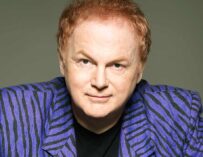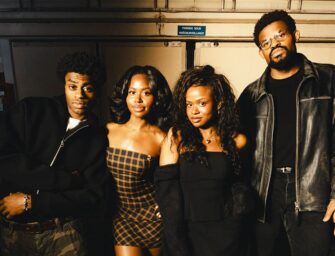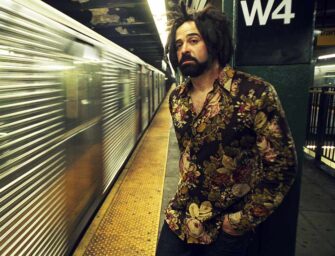
Saint Saviour: “I personally try too hard to perfect things, which really kills a song idea when it’s in its moment of pure potential.” Photo: Dunleavy Photography
Returning with her new alt-pop album Sunseeker, Becky Jones reflects on its creation and the insights gained along the way
When I began writing Sunseeker, we were just getting out of the dreaded C-word restrictions, so I was wound up as hell and desperate to get creative. It was that weird time where you knew that, often without warning, you’d suddenly be housebound again or the kids’ school would shut, and it was difficult to relax and ever feel like you could work with abandon. I also have a day job, lecturing a few days a week in a music college, so time is very tight. I was scraping songwriting sessions here and there between these times so I had to adapt my thought process and try to write more quickly. Here are some things I learned…
1. TO START A TOTALLY NEW ALBUM IDEA, GET OUT OF YOUR USUAL WRITING SPACE.
My house is noisy and messy, fantastically chaotic and full of life. However, I find it difficult in this environment to find the start of a new thread of an idea. Even when the kids are out, I’m still distracted by the mess and the laundry pile. It’s fine once I’ve found my direction, but just getting those first few ideas, I have started to go out to the coast to look for them. I see it as a conception and incubation activity – then I return to London with this little seed of an idea and I can then get into obsessive writing mode and I’m away.
It began with a trip to Hastings. I found a cute flat on Airbnb overlooking the sea at St Leonards[-on-Sea] and my other half gifted me a working week away. I set up my keyboard at the window and just stared at the sea all day for five days, brooding and writing. That’s how I started my last album Tomorrow Again. Something about looking into an endless sea and just daydreaming in total solitude, allowing things to come to you, it’s just creative heaven.
For Sunseeker, I went back to Hastings but I stayed in a funny little house in the middle of a big public park – it was the park keeper’s cottage – actually a bit scary at night on my own but during the day the park was beautiful and I could people-watch all day from the window!

Saint Saviour: “I find movement very helpful for creative thinking.”
2. NEVER WASTE TIME LABOURING OVER A SONG
Again, with maximising time in mind, I work at my keyboard and mic with Ableton Live open and ready to record ideas. I began to work with a new system where I only ever spend one hour on a single idea. So I sit at the keyboard, find a synth or keys noise I like, then I start improvising, keys and vocals. I aim to get an ‘A’ and a ‘B’ melody in that hour – so effectively, with an A and B you have the melodic I.D. of a full song.
I will just be scatting phonetic sounds with my voice – lyrics come later. But in that hour, I should have an A and B, then I quickly record, save the project, open a new one and start the process again. This way, I almost totally avoid that awful feeling when you lose hours and hours tweaking an idea that isn’t working to death. I’ll try and write four or five melodies in a day. I call them “nuggets”! At the end of a day like that, I won’t remember much about what I’ve done and I don’t go back to listen to them.
Then I’ll repeat this process for, say, a week or so, every week day I can between school-drop and pick-up. This way, you end up with those pure moments of inspiration and nothing else. Pre-kids, I spent too much time self-editing as I go and I have found that I personally try too hard to perfect things, which really kills a song idea when it’s in its moment of pure potential.
What I love about this technique is that, when you listen back to the ideas a couple of weeks later, you’re amazed by a lot of it, (some of it is also terrible). You can barely remember writing any of it, you have a volume of ideas, and you have this fresh perspective having had distance from them – and the feeling of fresh inspiration keeps coming.
3. WRITE ON THE MOVE
Once I have about 30 of these short A-B melodies and chords, I’ll make a playlist of them and get out of the house. I find movement very helpful for creative thinking. So I’m listening to myself singing these melodies but with gibberish phonetic sounds and scatting, and thinking about the character of the melody, what kind of words begin to come to mind which I could hang onto this melodic structure.
Walking whilst doing this seems to help me a lot, maybe it’s keeping a part of your brain engaged and distracted so you can fully daydream, maybe it’s that I’m taking in cues from the environment, but I write pretty much all of my lyrics while walking. It’s a bit dangerous but I walk and type words into my notes on my phone. Sometimes I’ll stop and sit in a churchyard or something – I live in SE1 London so I’m spoiled with Tower Bridge down the road, the Thames and the tourists who I find very interesting to watch.
Sometimes I’ll get on a random bus and just sit and go anywhere, whilst listening, looking from the windows and typing. I wrote the lyrics to Poetry from this album in a taxi. I actually woke up with a shock in St James’s Park one afternoon having accidentally fallen asleep while writing Cellophane during a quick sit-down. That song became about a statue in the park. I don’t know why, but if I’m still, my mind isn’t as agile with words.
Again, I will try not to overwork an idea, so I will move through the melody ideas quickly, making notes for each one, but never labouring too hard. This way I’m slowly writing around 10 songs at the same time. Essentially I never try too hard to write any element of a single song for too long, because I feel that it’s counterproductive.

Saint Saviour: “I never try too hard to write any element of a single song for too long.”
4. TRY WRITING TO A CLICK
For Sunseeker, I was intentionally trying to write some upbeat music, but when you sit down at the keyboard it’s quite natural and tempting to sit there and write a downbeat ballad, because the keyboard allows a luxurious, sustained sound, in contrast to a strummed or plucked guitar.
I started to listen to my reference songs and work out the BPM with a metronome, and then have a click or a beat going at that tempo while I composed. Using this technique, I find that you naturally begin to imagine a rhythmic groove building below the topline, and it keeps you in time. I know it can seem annoying to hear the metronome going the whole time, but I find that it’s really worth having it there to keep you on message with the tempo and try to write something with a motivated feeling.
5. FOR KEY-PLAYING WRITERS: TRY WRITING WITH A GUITAR SAMPLE OR VST INSTRUMENT
This was quite revolutionary for me. I wrote Rock Pools from my last album on an iPad using a really nice VST acoustic guitar instrument called Guitarism and I found that it unlocked something for me in terms of writing intentionally for guitar. To that point, this was the most upbeat song I’d written. Now I often write for guitar because I actually prefer the sound of plucked strings to the piano, especially when you want that light, gentle sound I love in albums by Sufjan Stevens and Aldous Harding.
Later, when writing Sunseeker, I shifted to using my keyboard again as a controller (Guitarism is great but you are a bit stuck in diatonic keys without fiddling to customise which tend to kill my flow) but using the guitar and dulcimer sounds on Spitfire Labs free sample packs. I absolutely love Spitfire Audio and I use the free packs a lot to explore sound when I’m writing.
I wrote most of the album only using these sounds and totally moved away from the sound of the piano. For Sunseeker, I think this was actually the defining sound of the album – when I took the songs to Bill [Ryder-Jones] to begin arranging and producing I had a lot of guitar-sound references and he did a huge amount of playing and arranging plucked parts and layers of counter melodies and rhythms.
I was aiming for a breezy sound and I think plucked strings cover the harmony without taking up too much space. Perhaps this is why people call it Baroque/Chamber Pop. I took this right through to the mixing stage, giving the engineer Nathan Boddy a lot of nylon and acoustic guitar reference sounds.






![Interview: Jessie Jo Dillon [2025]](https://www.songwritingmagazine.co.uk/wp-content/uploads/jessie-jo-dillon-2-by-libby-danforth-335x256.jpg)


























Related Articles